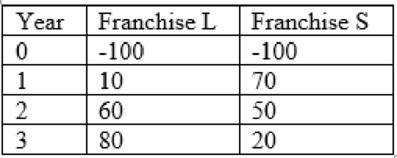
a)
Case summary:
Person X is graduated from large university. He desired to become an entrepreneur. After death of his grandfather he got a business worth of $1million. Then he decided to buy minimum one franchise in the area of fast foods.an issue behind is that he will sell off investment after 3 years and go on to something else.
Person X has two alternatives franchise L and franchise S. Franchise L providing breakfast and lunch while franchise S is providing only dinner. Person X made evaluation of each franchise and find out that both have characteristics of risk and needs
Here are the net cash flows (in thousand $)

To determine: The definition of
b)
To determine: The relationship between IRR and YTM and IRR if equal
c)
To determine: The logic behind the IRR method and the franchises must be accepted if they are independent and equally exclusive.
d)
To determine: Whether IRR changes with respect to change in cost of capital.
Trending nowThis is a popular solution!

Chapter 12 Solutions
INTERMEDIATE FINAN.MGMT.(LL)-W/MINDTAP
- Hello expert Give the answer please general accountingarrow_forwardScenario 2: The homepage for Coca-Cola Company can be found at coca-cola.com Links to an external site.. Locate the most recent annual report, which contains a balance sheet for the company. What is the book value of equity for Coca-Cola? The market value of a company is (# of shares of stock outstanding multiplied by the price per share). This information can be found at www.finance.yahoo.com Links to an external site., using the ticker symbol for Coca-Cola (KO). What is the market value of equity? Which number is more relevant to shareholders – the book value of equity or the market value of equity?arrow_forwardFILE HOME INSERT Calibri Paste Clipboard BIU Font A1 1 2 34 сл 5 6 Calculating interest rates - Excel PAGE LAYOUT FORMULAS DATA 11 Α΄ Α΄ % × fx A B C 4 17 REVIEW VIEW Alignment Number Conditional Format as Cell Cells Formatting Table Styles▾ Styles D E F G H Solve for the unknown interest rate in each of the following: Complete the following analysis. Do not hard code values in your calculations. All answers should be positive. 7 8 Present value Years Interest rate 9 10 11 SA SASA A $ 181 4 $ 335 18 $ 48,000 19 $ 40,353 25 12 13 14 15 16 $ SA SA SA A $ Future value 297 1,080 $ 185,382 $ 531,618arrow_forward
- B B Canning Machine 2 Monster Beverage is considering purchasing a new canning machine. This machine costs $3,500,000 up front. Required return = 12.0% Year Cash Flow 0 $-3,500,000 1 $1,000,000 2 $1,200,000 3 $1,300,000 4 $900,000 What is the value of Year 3 cash flow discounted to the present? 5 $1,000,000 Enter a response then click Submit below $ 0 Submitarrow_forwardFinances Income Statement Balance Sheet Finances Income Statement Balance Sheet Materia Income Statement Balance Sheet FY23 FY24 FY23 FY24 FY23 FY24 Sales Cost of Goods Sold 11,306,000,000 5,088,000,000 13,206,000,000 Current Current Assets 5,943,000,000 Other Expenses 4,523,000,000 5,283,000,000 Cash 211,000,000 328,600,000 Liabilities Accounts Payable 621,000,000 532,000,000 Depreciation 905,000,000 1,058,000,000 Accounts 502,000,000 619,600,000 Notes Payable 376,000,000 440,000,000 Earnings Before Int. & Tax 790,000,000 922,000,000 Receivable Interest Expense 453,000,000 530,000,000 Total Current Inventory 41,000,000 99,800,000 997,000,000 972,000,000 Taxable Income 337,000,000 392,000,000 Liabilities Taxes (25%) 84,250,000 98,000,000 Total Current 754,000,000 1,048,000,000 Long-Term Debt 16,529,000,000 17,383,500,000 Net Income Dividends 252,750,000 294,000,000 Assets 0 0 Fixed Assets Add. to Retained Earnings 252,750,000 294,000,000 Net Plant & 20,038,000,000 21,722,000,000…arrow_forwardDo you know what are Keith Gill's previous projects?arrow_forward
- Explain why long-term bonds are subject to greater interest rate risk than short-term bonds with references or practical examples.arrow_forwardWhat does it mean when a bond is referred to as a convertible bond? Would a convertible bond be more or less attractive to a bond holder than a non-convertible bond? Explain in detail with examples or academic references.arrow_forwardAlfa international paid $2.00 annual dividend on common stock and promises that the dividend will grow by 4% per year, if the stock’s market price for today is $20, what is required rate of return?arrow_forward
 Intermediate Financial Management (MindTap Course...FinanceISBN:9781337395083Author:Eugene F. Brigham, Phillip R. DavesPublisher:Cengage Learning
Intermediate Financial Management (MindTap Course...FinanceISBN:9781337395083Author:Eugene F. Brigham, Phillip R. DavesPublisher:Cengage Learning
 Managerial AccountingAccountingISBN:9781337912020Author:Carl Warren, Ph.d. Cma William B. TaylerPublisher:South-Western College Pub
Managerial AccountingAccountingISBN:9781337912020Author:Carl Warren, Ph.d. Cma William B. TaylerPublisher:South-Western College Pub EBK CONTEMPORARY FINANCIAL MANAGEMENTFinanceISBN:9781337514835Author:MOYERPublisher:CENGAGE LEARNING - CONSIGNMENT
EBK CONTEMPORARY FINANCIAL MANAGEMENTFinanceISBN:9781337514835Author:MOYERPublisher:CENGAGE LEARNING - CONSIGNMENT Survey of Accounting (Accounting I)AccountingISBN:9781305961883Author:Carl WarrenPublisher:Cengage Learning
Survey of Accounting (Accounting I)AccountingISBN:9781305961883Author:Carl WarrenPublisher:Cengage Learning





